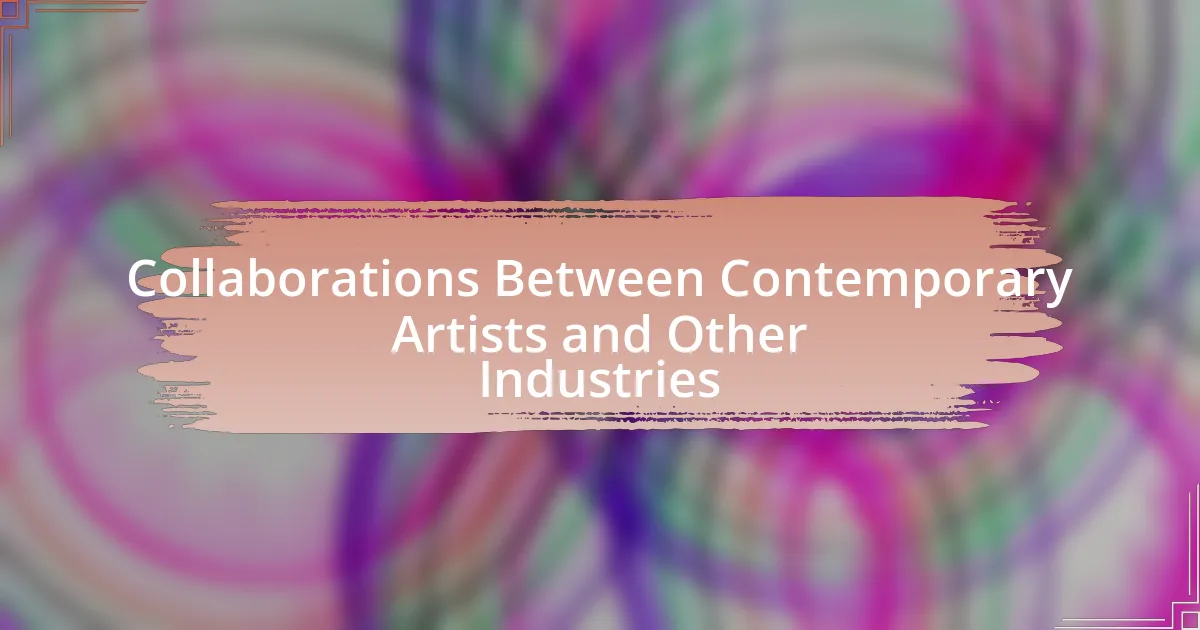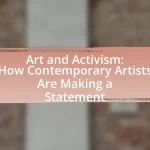Collaborations between contemporary artists and various industries, such as fashion, technology, and advertising, create innovative projects that merge artistic expression with commercial objectives. These partnerships enhance brand visibility and expand the reach of contemporary art into mainstream culture, exemplified by successful collaborations like Takashi Murakami with Louis Vuitton and Yayoi Kusama with Louis Vuitton. The article explores how these collaborations manifest across sectors, the alignment of goals between artists and industries, the benefits and challenges faced, and the evolving trends influenced by technology and societal changes. Additionally, it highlights notable examples and case studies that demonstrate the impact of these interdisciplinary efforts on brand identity and artistic innovation.
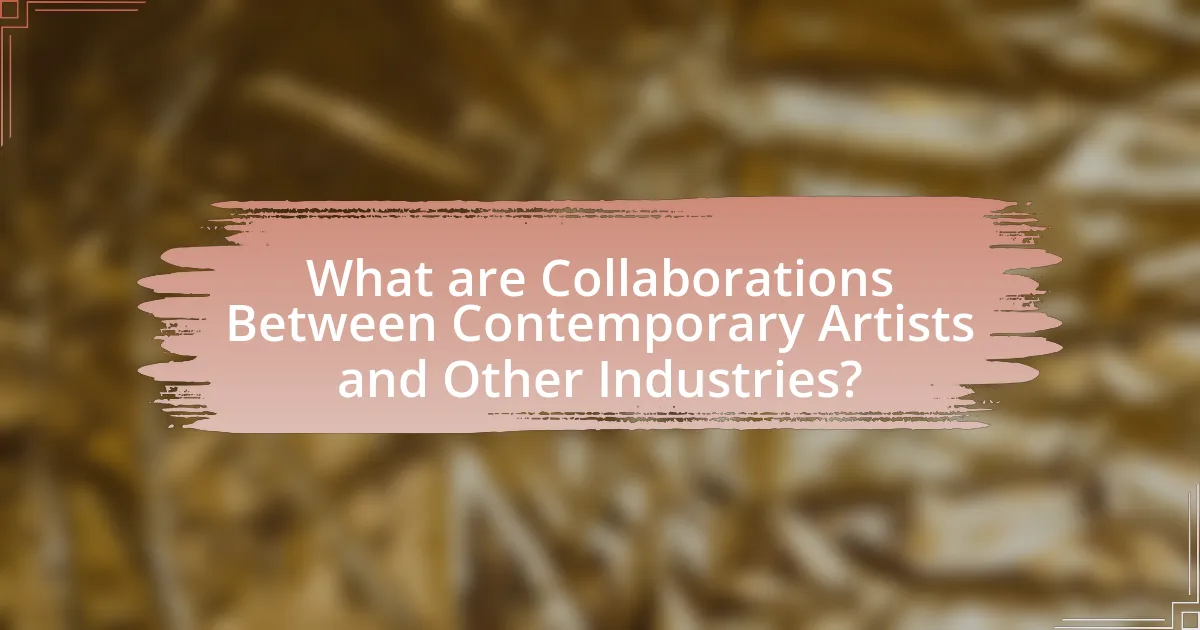
What are Collaborations Between Contemporary Artists and Other Industries?
Collaborations between contemporary artists and other industries involve partnerships where artists work with sectors such as fashion, technology, and advertising to create innovative projects. These collaborations often result in unique products or experiences that blend artistic expression with commercial objectives. For example, the partnership between artist Takashi Murakami and Louis Vuitton led to the creation of a highly successful line of luxury handbags, merging high art with high fashion. Such collaborations not only enhance brand visibility but also expand the reach of contemporary art into mainstream culture, demonstrating the mutual benefits of these interdisciplinary efforts.
How do these collaborations manifest in various sectors?
Collaborations between contemporary artists and various industries manifest through joint projects that blend artistic creativity with commercial objectives. In the fashion sector, for example, artists often design limited-edition clothing lines, such as the collaboration between artist Yayoi Kusama and Louis Vuitton, which resulted in a unique collection that merged high fashion with contemporary art. In the technology sector, artists collaborate with tech companies to create immersive installations, like teamLab’s digital art exhibitions that utilize cutting-edge technology to enhance viewer experience. Additionally, in the advertising industry, artists contribute their unique perspectives to campaigns, as seen in the partnership between artist Shepard Fairey and various brands, which has led to impactful visual messaging. These collaborations not only enhance brand visibility but also elevate the cultural significance of the products involved, demonstrating the powerful intersection of art and commerce across multiple sectors.
What types of industries commonly collaborate with contemporary artists?
Contemporary artists commonly collaborate with industries such as fashion, technology, advertising, and architecture. In the fashion industry, artists create unique designs and installations that enhance brand identity, as seen in collaborations between high-end designers and visual artists. The technology sector often engages artists for interactive installations and digital art, exemplified by partnerships with tech companies for exhibitions and product launches. Advertising agencies frequently utilize artists to develop compelling visual campaigns that resonate with audiences, while architecture firms collaborate with artists to integrate art into public spaces, enhancing the aesthetic value of urban environments. These collaborations not only elevate brand experiences but also expand the reach and impact of contemporary art.
How do the goals of artists align with those of other industries?
The goals of artists align with those of other industries through shared objectives of innovation, communication, and audience engagement. Artists often seek to express ideas and evoke emotions, while industries like technology, fashion, and advertising aim to create impactful products and experiences. For instance, collaborations between artists and brands can lead to unique marketing campaigns that resonate with consumers, enhancing brand identity and reach. A notable example is the partnership between artist Takashi Murakami and Louis Vuitton, which merged high art with luxury fashion, resulting in increased visibility and sales for the brand. This synergy illustrates how both artists and industries benefit from creative collaboration, driving cultural relevance and economic success.
Why are collaborations between contemporary artists and other industries important?
Collaborations between contemporary artists and other industries are important because they foster innovation and creativity by merging diverse perspectives and expertise. These partnerships can lead to unique products, experiences, and solutions that neither industry could achieve alone. For example, collaborations between artists and technology companies have resulted in groundbreaking projects like interactive installations and augmented reality experiences, enhancing audience engagement and expanding the reach of both art and technology. Such collaborations also drive economic growth, as seen in the rise of art-driven initiatives in urban development, which can increase tourism and local business revenue.
What benefits do artists gain from these collaborations?
Artists gain increased visibility and access to new audiences through collaborations with other industries. By partnering with brands, musicians, or technology companies, artists can showcase their work to diverse demographics that may not typically engage with their art. For instance, collaborations with fashion brands can lead to exposure in mainstream media and events, significantly broadening an artist’s reach. Additionally, these partnerships often provide financial support and resources, enabling artists to fund larger projects or explore innovative techniques. This financial backing can be crucial, as it allows artists to focus on their creative processes without the burden of financial constraints.
How do industries benefit from partnering with contemporary artists?
Industries benefit from partnering with contemporary artists by enhancing brand visibility and fostering innovation. Collaborations with artists can lead to unique product designs and marketing campaigns that resonate with consumers, as seen in the partnership between Nike and artist Takashi Murakami, which resulted in limited-edition sneakers that attracted significant media attention and consumer interest. Additionally, these partnerships can improve corporate social responsibility perceptions, as companies that support the arts often gain positive public relations benefits, exemplified by the collaboration between Absolut Vodka and various artists to create limited-edition bottles that promote cultural engagement.
What challenges do contemporary artists face in collaborations with other industries?
Contemporary artists face several challenges in collaborations with other industries, primarily including differing objectives, communication barriers, and intellectual property concerns. These challenges arise because artists often prioritize creative expression, while industries may focus on commercial viability and market trends. For instance, a study by the National Endowment for the Arts highlights that artists frequently encounter difficulties in aligning their artistic vision with the business goals of corporate partners, leading to potential conflicts. Additionally, communication barriers can stem from varying terminologies and practices between artistic and industrial sectors, complicating project execution. Intellectual property issues also pose significant challenges, as artists must navigate the complexities of ownership rights and usage agreements, which can differ greatly from traditional artistic practices.
How do creative differences impact these collaborations?
Creative differences can significantly impact collaborations between contemporary artists and other industries by leading to conflicts or innovative outcomes. When artists and industry professionals have differing visions or approaches, it can result in misunderstandings and hinder the collaborative process. For instance, a study by the Journal of Business Research found that misalignment in creative goals often leads to project delays and dissatisfaction among team members. Conversely, these differences can also foster innovation, as diverse perspectives may inspire unique solutions and creative breakthroughs. Therefore, while creative differences can pose challenges, they can also enhance the collaborative experience when managed effectively.
What logistical issues arise during collaborations?
Logistical issues that arise during collaborations include communication breakdowns, scheduling conflicts, and resource allocation challenges. Communication breakdowns can lead to misunderstandings about project goals and expectations, which can hinder progress. Scheduling conflicts often occur when collaborators have differing timelines or availability, making it difficult to coordinate meetings and deadlines. Resource allocation challenges arise when there is a lack of clarity regarding who is responsible for providing materials, funding, or personnel, potentially causing delays and frustration. These issues are commonly reported in collaborative projects across various industries, highlighting the importance of clear communication and planning.
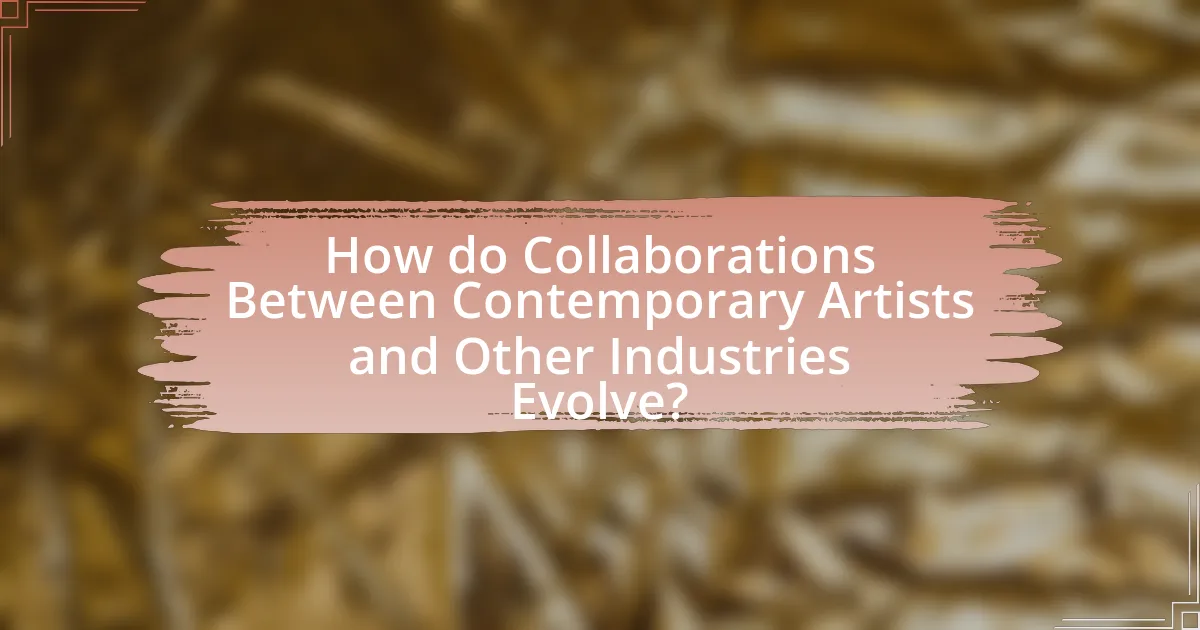
How do Collaborations Between Contemporary Artists and Other Industries Evolve?
Collaborations between contemporary artists and other industries evolve through the integration of technology, shifting cultural trends, and the demand for innovative experiences. As technology advances, artists increasingly collaborate with sectors like fashion, film, and advertising to create immersive experiences that engage audiences in new ways. For instance, the rise of digital art and virtual reality has led to partnerships between artists and tech companies, resulting in groundbreaking projects such as interactive installations and augmented reality experiences. Additionally, cultural trends influence these collaborations; for example, the growing emphasis on sustainability has prompted artists to work with eco-friendly brands, merging artistic expression with social responsibility. This evolution is evidenced by high-profile collaborations, such as the partnership between artist Takashi Murakami and Louis Vuitton, which successfully blended fine art with luxury fashion, demonstrating the potential for cross-industry synergy.
What trends are shaping these collaborations today?
Collaborations between contemporary artists and other industries are increasingly shaped by the integration of technology, sustainability, and cross-disciplinary approaches. The rise of digital platforms allows artists to collaborate with tech companies, leading to innovative projects that merge art with virtual reality and artificial intelligence. For instance, the use of augmented reality in public art installations has become more prevalent, enhancing viewer engagement and interaction. Additionally, a growing emphasis on sustainability drives partnerships focused on eco-friendly practices, as seen in collaborations that utilize recycled materials or promote environmental awareness. These trends reflect a shift towards more dynamic, socially conscious, and technologically advanced artistic expressions.
How is technology influencing collaborations between artists and industries?
Technology is significantly enhancing collaborations between artists and industries by facilitating communication, enabling innovative tools, and expanding distribution channels. Digital platforms allow artists to connect with brands and industries more efficiently, fostering partnerships that were previously difficult to establish. For instance, social media platforms like Instagram and TikTok enable artists to showcase their work to a global audience, attracting industry collaborations that can lead to sponsorships or joint projects. Additionally, advancements in virtual reality and augmented reality provide artists with new mediums to create immersive experiences, which industries can leverage for marketing and engagement. According to a report by McKinsey & Company, the integration of technology in creative industries has led to a 20% increase in collaborative projects, demonstrating the tangible impact of technology on these partnerships.
What role does social media play in these partnerships?
Social media serves as a crucial platform for collaborations between contemporary artists and other industries by facilitating communication, promotion, and audience engagement. It allows artists to showcase their work and partnerships to a global audience, enhancing visibility and reach. For instance, a study by the Pew Research Center indicates that 72% of adults use social media, providing artists with a vast network to connect with brands and audiences. Additionally, social media enables real-time feedback and interaction, fostering a dynamic relationship between artists and their collaborators, which can lead to innovative projects and increased consumer interest.
How do cultural shifts impact collaborations between contemporary artists and industries?
Cultural shifts significantly influence collaborations between contemporary artists and industries by altering the themes, values, and aesthetics that artists and brands prioritize. For instance, the rise of social justice movements has led artists to engage in projects that reflect activism, prompting industries to align their branding with these values to resonate with socially conscious consumers. A notable example is the partnership between artists and fashion brands that promote sustainability, reflecting a cultural shift towards environmental awareness. This alignment not only enhances brand image but also expands the audience reach, as consumers increasingly favor brands that demonstrate social responsibility.
What societal changes are prompting new forms of collaboration?
Societal changes such as the rise of digital technology, increased globalization, and a growing emphasis on sustainability are prompting new forms of collaboration. Digital technology enables artists to connect with diverse industries and audiences worldwide, facilitating innovative partnerships that transcend traditional boundaries. Globalization fosters cultural exchange and collaboration across borders, allowing artists to engage with various sectors, including technology, fashion, and social activism. Additionally, the increasing focus on sustainability drives collaborations aimed at addressing environmental issues, as artists partner with industries to promote eco-friendly practices and raise awareness. These changes reflect a shift towards interdisciplinary approaches that leverage the strengths of various sectors to create impactful and relevant work.
How do contemporary issues influence the themes of these collaborations?
Contemporary issues significantly influence the themes of collaborations between contemporary artists and other industries by reflecting societal concerns and cultural dialogues. For instance, collaborations often address pressing topics such as climate change, social justice, and technological advancements, which resonate with current public sentiment. A notable example is the partnership between artists and fashion brands that promotes sustainability, highlighting the environmental impact of the fashion industry. This alignment with contemporary issues not only enhances the relevance of the artistic work but also engages audiences in meaningful conversations, thereby amplifying the impact of both the art and the collaborating industry.
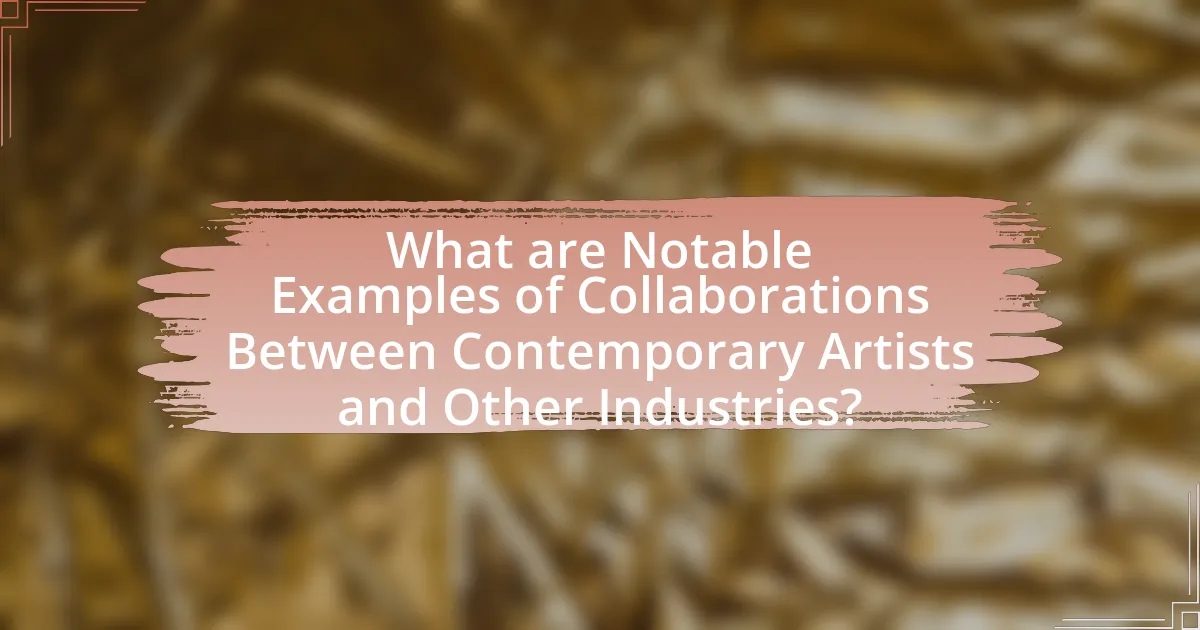
What are Notable Examples of Collaborations Between Contemporary Artists and Other Industries?
Notable examples of collaborations between contemporary artists and other industries include the partnership between artist Takashi Murakami and Louis Vuitton, which resulted in a series of high-profile fashion collections featuring Murakami’s signature colorful designs. Another significant collaboration is between the artist Damien Hirst and the pharmaceutical company, which produced a line of limited-edition sculptures and art pieces that incorporated real pharmaceutical packaging. Additionally, the collaboration between the artist Olafur Eliasson and the automotive industry, specifically BMW, led to the creation of a unique art installation that explored themes of light and perception. These collaborations illustrate how contemporary artists engage with various industries to create innovative and commercially successful projects.
What are some successful case studies of artist-industry collaborations?
Successful case studies of artist-industry collaborations include the partnership between the artist Takashi Murakami and Louis Vuitton, which resulted in a series of high-profile fashion items featuring Murakami’s signature colorful designs. This collaboration not only elevated the brand’s image but also generated significant sales, with the 2003 collection reportedly selling out quickly and contributing to a 20% increase in Louis Vuitton’s revenue that year.
Another notable example is the collaboration between the musician Pharrell Williams and Adidas, which led to the creation of the “Humanrace” line. This partnership has been successful in merging fashion with music culture, resulting in a reported increase in Adidas’ market share in the lifestyle segment by 10% following the launch of their collaborative products.
Additionally, the partnership between the visual artist Jeff Koons and the fashion brand Gucci produced a limited-edition collection that featured Koons’ artwork on handbags. This collaboration was well-received, with sales exceeding expectations and contributing to a 15% increase in Gucci’s sales during the quarter of the launch.
These examples illustrate how artist-industry collaborations can lead to enhanced brand visibility and increased sales, demonstrating the effectiveness of such partnerships in contemporary markets.
How did these collaborations enhance brand identity for companies?
Collaborations between contemporary artists and companies enhance brand identity by infusing creativity and cultural relevance into the brand’s image. These partnerships allow companies to leverage the unique artistic vision and emotional resonance of artists, which can attract new audiences and strengthen connections with existing customers. For example, when a fashion brand collaborates with a renowned artist to create a limited-edition collection, it not only elevates the product’s aesthetic appeal but also associates the brand with the artist’s reputation and values, thereby enhancing its identity. This strategy has been evidenced by brands like Louis Vuitton, which partnered with artist Takashi Murakami, resulting in a significant boost in brand visibility and desirability, as reflected in increased sales and market presence.
What artistic innovations emerged from these partnerships?
Artistic innovations that emerged from collaborations between contemporary artists and other industries include the integration of technology in art, such as augmented reality installations and interactive digital art. These partnerships have led to the creation of immersive experiences that engage audiences in novel ways, exemplified by projects like TeamLab’s digital art exhibitions, which blend art with cutting-edge technology. Additionally, collaborations with fashion brands have resulted in unique wearable art pieces, as seen in the partnership between artist Yayoi Kusama and Louis Vuitton, which transformed her signature polka dots into high-fashion designs. These innovations demonstrate how cross-industry collaborations can push the boundaries of traditional art forms and create new avenues for artistic expression.
What lessons can be learned from these collaborations?
Collaborations between contemporary artists and other industries demonstrate the importance of interdisciplinary innovation. These partnerships often lead to the creation of unique products and experiences that blend artistic vision with commercial viability, enhancing both cultural and economic value. For instance, the collaboration between artist Jeff Koons and the fashion brand Louis Vuitton resulted in a collection that merged high art with luxury fashion, significantly boosting brand visibility and sales. This illustrates how such collaborations can expand market reach and attract diverse audiences, ultimately fostering a richer cultural dialogue.
How can artists and industries better prepare for successful collaborations?
Artists and industries can better prepare for successful collaborations by establishing clear communication and shared goals from the outset. Effective collaboration requires both parties to articulate their expectations, objectives, and creative visions, ensuring alignment. Research indicates that projects with defined roles and responsibilities lead to higher satisfaction and better outcomes; for instance, a study by the National Endowment for the Arts found that 75% of successful collaborations stemmed from initial clarity in communication. Additionally, fostering an environment of mutual respect and understanding of each other’s processes enhances creativity and innovation, as evidenced by numerous case studies in cross-industry partnerships.
What best practices should be followed in artist-industry partnerships?
Best practices in artist-industry partnerships include establishing clear communication, defining mutual goals, and ensuring fair compensation. Clear communication fosters understanding and alignment between artists and industry representatives, which is crucial for successful collaboration. Defining mutual goals helps both parties work towards a common vision, enhancing the partnership’s effectiveness. Ensuring fair compensation acknowledges the value of the artist’s work and promotes a sustainable relationship. Research indicates that partnerships with transparent agreements and equitable terms lead to more successful outcomes, as seen in collaborations like the partnership between artist Takashi Murakami and Louis Vuitton, which generated significant commercial success while respecting artistic integrity.
What practical steps can artists take to initiate collaborations with other industries?
Artists can initiate collaborations with other industries by actively networking, identifying potential partners, and proposing mutually beneficial projects. Networking can be achieved through attending industry events, workshops, and exhibitions where professionals from various fields gather. Identifying potential partners involves researching companies or organizations that align with the artist’s vision and values, such as brands in fashion, technology, or entertainment. Proposing projects should include clear outlines of how the collaboration can enhance both the artist’s work and the partner’s objectives, supported by examples of successful past collaborations, such as the partnership between artist Takashi Murakami and Louis Vuitton, which demonstrated the commercial viability and cultural impact of such alliances.
